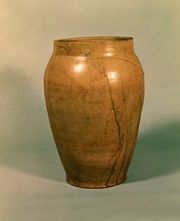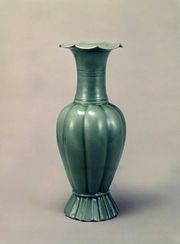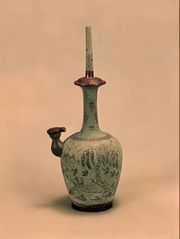"2018 GGHS Team 2"의 두 판 사이의 차이
(→Found Goryeo celadon) |
|||
| 54번째 줄: | 54번째 줄: | ||
[[File:청자순화4년명호(사진).jpg|thumbnail|Celadon with ‘淳化四年’Treasure number 237 <ref>[http://encykorea.aks.ac.kr/Contents/SearchNavi?keyword=%EC%B2%AD%EC%9E%90%EC%88%9C%ED%99%944%EB%85%84%EB%AA%85%ED%98%B8&ridx=0&tot=4911# 한국민족문화대백과]</ref>]] | [[File:청자순화4년명호(사진).jpg|thumbnail|Celadon with ‘淳化四年’Treasure number 237 <ref>[http://encykorea.aks.ac.kr/Contents/SearchNavi?keyword=%EC%B2%AD%EC%9E%90%EC%88%9C%ED%99%944%EB%85%84%EB%AA%85%ED%98%B8&ridx=0&tot=4911# 한국민족문화대백과]</ref>]] | ||
| − | This is a celadon pot with ‘淳化四年’ made in 993 years by the late 10th century, when Goryeo began to make the celadon pot in earnest. It is difficult to see it as a celadon, because it is yellow in color and the glaze is not completely dissolved and is running down. It was used in the shrine of Taejo of Goryeo as it was a highly developed listener in 993 years. Unlike a gas kiln, the success rate of the kiln at that time was less than 20 percent, and we can know how many failures there were through 10 to 15 meters of sediment found in the celadon pot. | + | #Celadon with ‘淳化四年’Treasure number 237 This is a celadon pot with ‘淳化四年’ made in 993 years by the late 10th century, when Goryeo began to make the celadon pot in earnest. It is difficult to see it as a celadon, because it is yellow in color and the glaze is not completely dissolved and is running down. It was used in the shrine of Taejo of Goryeo as it was a highly developed listener in 993 years. Unlike a gas kiln, the success rate of the kiln at that time was less than 20 percent, and we can know how many failures there were through 10 to 15 meters of sediment found in the celadon pot.[[File:청자참외모양꽃병.jpg|thumbnail|The celadon vase with the shape of oriental melon National Treasure number 94 <ref>[http://encykorea.aks.ac.kr/Contents/SearchNavi?keyword=%EC%B2%AD%EC%9E%90%EC%B0%B8%EC%99%B8%EB%AA%A8%EC%96%91%EA%BD%83%EB%B3%91&ridx=0&tot=798 한국민족문화대백과]</ref>]] |
| + | #The celadon vase with the shape of oriental melon/ National Treasure number 94 Regardless of the book introducing the Goryeo celadon, it is presented on the first page, the first section, and the first page. As this vase is a vase for kings, it contains the authority of the royal culture. The celadon has a long neck, and the overhang of the head shows the authority the king can have. In the 12th century, Goryeo celadon, which is unsatisfactory with the design ofintaglio decoration or relievo decoration, was characterized by peach, melon, turtle, duck, topsoil, bamboo shoots, and other small pieces of celadon. [[File:청동은입사포유수금문정병.jpg|thumbnail|A bottle of silver thread in bronze with patterns of grapes, willow and waterfowl. National Treasure Number 92 <ref>[http://encykorea.aks.ac.kr/Contents/SearchNavi?keyword=%EC%B2%AD%EB%8F%99%EC%9D%80%EC%9E%85%EC%82%AC%ED%8F%AC%EC%9C%A0%EC%88%98%EA%B8%88%EB%AC%B8%EC%A0%95%EB%B3%91&ridx=1&tot=6214 한국민족문화대백과]</ref>]] | ||
| + | #Compared to China, which has started to focus on white porcelain, the Goryeo people dug a hole in a bronze bowl and pushed a silver chamber into a pattern or put shells in wood that they were inspired by the lacquerware inlaid with mother-of-pearl’ technique. [[File:GetImage.jpg|thumbnail|Sanggam celadon rice bowl with a vine pattern National Treasure Number 115 <ref> [http://encykorea.aks.ac.kr/Search/List 한국민족문화대백과]</ref>]] | ||
| + | #The oldest of the Sanggam celadon was not engraved with intaglio decoration or relievo decoration, | ||
| + | but patterns, which is believed to have been unearthed from the tomb of Moongong Yuyu, which died in 1159. The Sanggam celadon are the greatest inventions that we have ever made in China. As late as the beginning of the 13th century, 90 percent of Goryeo celadon is made of Sanggam celadon. It is a collection of lotus and lotus flowers, lotus plates, chrysanthemum buds, phoenixes, clouds, willow and waterfowl. A variety of patterns for reading the lyricism of the Goryeo people are represented by the designs of Sanggam celadon.[[File:GetImage (1).jpg|thumbnailA narrow, wide-shouldered, down-looking, down-shaped Sanggam celadon / National Treasure Number 68 <ref>[http://encykorea.aks.ac.kr/Contents/SearchNavi?keyword=%EC%B2%AD%EC%9E%90%EC%83%81%EA%B0%90%EC%9A%B4%ED%95%99%EB%AC%B8%EB%A7%A4%EB%B3%91&ridx=0&tot=244 한국민족문화대백과]</ref>]] | ||
| + | #One of the most luxurious brands of the Sanggam celadon is the Sanggam celadon with a pattern of cloud and crane. Consider the celadon as the blue sky and have a design filled with cirrus clouds and crane. | ||
='''Chemistry in Goryeo celadon'''= | ='''Chemistry in Goryeo celadon'''= | ||
2018년 7월 26일 (목) 16:37 판
목차
Team Information
| Team Position | Name (English) | Name (Korean) | Student ID | Wiki ID |
|---|---|---|---|---|
| Teacher | Jee Eun Kwon | 권지은 | Jeeeun | |
| Leader | Seo Ji Woo | 서지우 | 2710 | seojiwoo |
| Vice-Leader | Hee Won Woo | 우희원 | 2404 | xiyuan28 |
| Member | Haeun Koh | 고하은 | 2501 | 고하은 |
| Member | Se Mi Park | 박세미 | 2512 | myid4 |
| Member | Hae Won Bong | 봉해원 | 2709 | myid5 |
| Member | Ji Hye Lee | 이지혜 | 1218 | myid4 |
| Member | Min Gyeong Choi | 최민경 | 1320 | myid4 |
Goryeo celadon
Origin of Goryeo celadon
The Goryeo celadon that we talk about as an art piece is a porcelain made of clay and coated with glaze and baked over 1,300 degrees Celsius. In China, jade symbolized a man of virtue and used it as a burial object, believing that it meant eternal life and drove out demons. At that time, the ruling class had many desires for jade and many people wanted to bury jade in their parents ' graves. However, the jade production was so small that they tried to turn precious jade into clay during the period. In Korea, Chinese celadon has been found in ancient tombs between 4 and 6 C, which can be found by importing Chinese celadon as royal jade. The color of Goryeo celadon was an advanced technique 1,000 years ago. In the 3rd and 4th centuries, China created a yellow celadon from Wolju Gama, and was not until the 9th century that it produced perfect celadon. The Buddhist Zen sect, which was widely practiced in China around the 9th century, began to use Goryeo celadon as a tea cup as its practice, as the habit of drinking tea to clear one's mind while meditating. The Chinese made perfect celadon, then the Goryeo people back-track it and created the Goryeo celadon at 11C. Chinese celadon is in its heyday during the reign of Emperor Huizong in 12C, and Goryeo celadon also hits peaks in 12C. We traced the celadon from 1,500 years of study by the Chinese and created it in 200 years. Afterwards, excellent Goryeo celadon started to be produced in Gangjin, Jeolla-do, and Gochang, looking for high-quality soil. In the beginning, Goryeo celadon is usually brown and is made of neat, intelligent, and neat celadon, but in the 12th century, it has been painted with patterns. At that time, the world of Goryeo people was a Buddhist world. They held their hearts in the Goryeo celadon and prayed for eternal world. For example, they used ponds, a world of Buddhist virtues, willow trees, ducks playing along the water, and wild flowers that showed silence and silence. This is why Goryeo celadon, which contains hundreds of years of desire for life, created the most beautiful pottery in the world. [1]
Techniques used in Goryeo celadon
● Sanggam technique (상감기법)
The Sanggam technique is to dig a pattern using a sharp carving knife, and then to express a painting with mud deposits on the brush by using a method that can fill the part with more colored mud. Clay shrinks as the moisture evaporates, so it is often formed by the contraction of the other colored soil in the based soil and the intaglioed based soil.
● Intaglio relief technique (음각, 양각 기법)
It is a technique to make a shape of a vessel and dig out a pattern with a fine line before the soil dries, or bend the outer edge of a pattern to show off the pattern. It is the most basic technique from around the 11th century to the end of the Goryeo Dynasty, getting out from the early stage of the production.
● Ron-brown underglaze on white slip and Underglaze slip techniques (철화, 퇴화 기법)
Ron-brown underglaze on white slip and Underglaze slip techniques are techniques that express patterns in a manner that looks like paint on the surface of a baked vessel. The section of the finished product has a layer of earth patterned over the based soil layer, and then a layer of organic material overlaid on top of it, divided into iron oxide and degeneration according to the color of the painting. Ron-brown underglaze on white slip technique is known as iron oxide when it is painted with a black pattern on it. Underglaze slip technique refers to a technique in which patterns are drawn in black and white in the finished product, using red and white soil containing little iron.
● extrude relief technique (압출, 양각 기법)
It is a technique that pushes a properly dried bowl into a frame carved with the pattern of the bowl. This technique let pattern stand out. It can saves more time than carving out patterns one by one, and produces more vessels of the same type. The vessels are usually of many types suitable for printing, plates, and whole, and are usually patterned on the inner surface of the vessel.
● copper oxide Technique (동화(산화동)기법)
oxidized copper is also called jinsa. This is because when you burn it with reductant, it becomes red. However, it is very difficult to make red because copper oxide is very unstable depending on conditions such as temperature control and fuel supply. The copper oxide is expressed only in parts such as the buds of flowers and the edges of petals with an inlaid technique. There are also a few techniques made by painting the front of the bowl with copper oxide. [2]
Found Goryeo celadon

- Celadon with ‘淳化四年’Treasure number 237 This is a celadon pot with ‘淳化四年’ made in 993 years by the late 10th century, when Goryeo began to make the celadon pot in earnest. It is difficult to see it as a celadon, because it is yellow in color and the glaze is not completely dissolved and is running down. It was used in the shrine of Taejo of Goryeo as it was a highly developed listener in 993 years. Unlike a gas kiln, the success rate of the kiln at that time was less than 20 percent, and we can know how many failures there were through 10 to 15 meters of sediment found in the celadon pot.
 The celadon vase with the shape of oriental melon National Treasure number 94 [4]
The celadon vase with the shape of oriental melon National Treasure number 94 [4] - The celadon vase with the shape of oriental melon/ National Treasure number 94 Regardless of the book introducing the Goryeo celadon, it is presented on the first page, the first section, and the first page. As this vase is a vase for kings, it contains the authority of the royal culture. The celadon has a long neck, and the overhang of the head shows the authority the king can have. In the 12th century, Goryeo celadon, which is unsatisfactory with the design ofintaglio decoration or relievo decoration, was characterized by peach, melon, turtle, duck, topsoil, bamboo shoots, and other small pieces of celadon.
 A bottle of silver thread in bronze with patterns of grapes, willow and waterfowl. National Treasure Number 92 [5]
A bottle of silver thread in bronze with patterns of grapes, willow and waterfowl. National Treasure Number 92 [5] - Compared to China, which has started to focus on white porcelain, the Goryeo people dug a hole in a bronze bowl and pushed a silver chamber into a pattern or put shells in wood that they were inspired by the lacquerware inlaid with mother-of-pearl’ technique.
 Sanggam celadon rice bowl with a vine pattern National Treasure Number 115 [6]
Sanggam celadon rice bowl with a vine pattern National Treasure Number 115 [6] - The oldest of the Sanggam celadon was not engraved with intaglio decoration or relievo decoration,
but patterns, which is believed to have been unearthed from the tomb of Moongong Yuyu, which died in 1159. The Sanggam celadon are the greatest inventions that we have ever made in China. As late as the beginning of the 13th century, 90 percent of Goryeo celadon is made of Sanggam celadon. It is a collection of lotus and lotus flowers, lotus plates, chrysanthemum buds, phoenixes, clouds, willow and waterfowl. A variety of patterns for reading the lyricism of the Goryeo people are represented by the designs of Sanggam celadon.![thumbnailA narrow, wide-shouldered, down-looking, down-shaped Sanggam celadon / National Treasure Number 68 [7]](/Edu/wiki/images/7/70/GetImage_%281%29.jpg)
- One of the most luxurious brands of the Sanggam celadon is the Sanggam celadon with a pattern of cloud and crane. Consider the celadon as the blue sky and have a design filled with cirrus clouds and crane.
Chemistry in Goryeo celadon
A Study on Jade Green Colors in Goryeo celadon
Was not opened to the public because the method of production of Goryeo celadon was secret, and Goryeo celadon gradually declined from the 13th century to the 16th century. So unfortunately, it was not easy to solve now the mystery of Goryeo celadon's non-blown color. But now, it is estimated that there are two results that many scholars have studied about the jade green of Goryeo celadon.
1) Some scholars who studied Goryeo celadon argued that the secret of jade green lies in the glaze.
The glaze contained iron and silicon dioxide (SiO2), which were combinedm, Silicate iron (FeSiO2) to give the Goryeo celadon a jade green color. This was based on the fact that silicon made up more than half of the glaze.
2) According to a recent study, a new theory suggests that the source of jade green is not the silicon of glaze but rather the iron ions (Fe2 +) of iron oxide. Though the based soil and glaze contained only Fe3 +, the fe . Fe3+ ion is greatly reduced after the celadon is baked, the fe2 + amount is based on an increase. The reason why Fe3+ion has been changed to Fe2+ion is because it burns Goryeo celadon from reducing flames.
What is reducing flames? To know about reductitis, you need to know about the type of fire that burns pottery, an oxidizing and reducing flames. An oxidizing flame is a fire that is completely clean and burned with sufficient oxygen and is red. On the other hand, it is called reductivitis, which is blue when there is less oxygen and less fuel burning. In other words, in oxidative flames, there is more oxygen left than the oxygen requirements for fire, so the extra oxygen combines with the iron in the based soil, making the color red, Fe2O3. Reductitis flames, on the other hand, is caused by lack of oxygen due to fire in an airtight kiln. They also continue to provide firewood before the fire is completely burned to ashes, causing black smoke and soot to form, leaving the kiln incomplete combustion. This type of reductant causes carbon monoxide to form as the fire burns incompletely. This carbon monoxide pulls oxygen from the receiver's surface to make it more stable to form carbon dioxide, resulting in a lack of oxygen on the receiver's surface. As a result, the Fe2O3, which had been combined with oxygen in the glaze or tatto, lost oxygen and returned to the feO, and that have a blue light. Fe2O3+CO→2FeO+CO2. In other words, the secret of jade green color Goryeo celadon lies in the fact that the iron ions are return from Fe3+ion to Fe2+ion. The research team used advanced technology such as electron microscope and optoelectronic spectrum analysis to reveal the above. [8]
